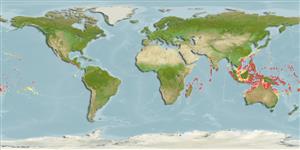Classification / Names
Common names from other countries
Main reference
Size / Weight / Age
Max length : 10.0 cm TL male/unsexed; (Ref. 48635)
Environment
Marine; reef-associated; depth range 2 - 64 m (Ref. 11890)
Climate / Range
Tropical, preferred ?; 32°N - 28°S
Distribution
Short description
Dorsal
spines
(total): 7;
Dorsal
soft rays
(total): 8;
Anal
spines: 2;
Anal
soft rays: 7 - 8;
Vertebrae: 24. Translucent when fresh with a reddish cast, overlaid with iridescence particularly on abdomen and operculum predominated by golden hues; dusky caudal fin with hyaline border; 1st and 2nd dorsal and anal fin pale to dusky or blackish, other fins are clear with pink rays. Anterior nostril without long flap. Rhomboid caudal fin. 23-24 scales in longitudinal series. Gill rakers 4-5+11-13, 1-7 developed. Convex interorbital space. Oblique mouth. Predorsal scales 10 (9-11). This species resembles P. amblyuroptera and P. gelatinosa but has larger scales (LR<=24) (Ref. 37816).
IUCN Red List Status (Ref. 115185)
Threat to humans
Harmless
Human uses
More information
ReferencesAquacultureAquaculture profileStrainsGeneticsAllele frequenciesHeritabilityDiseasesProcessingMass conversion
Tools
Special reports
Download XML
Internet sources
Estimates of some properties based on models
Phylogenetic diversity index
PD50 = 0.5078 many relatives (e.g. carps) 0.5 - 2.0 few relatives (e.g. lungfishes)
Trophic Level
3.5 ±0.50 se; Based on food items.
Resilience
High, minimum population doubling time less than 15 months (Preliminary K or Fecundity.)
Vulnerability
Low vulnerability (11 of 100)
Price category
